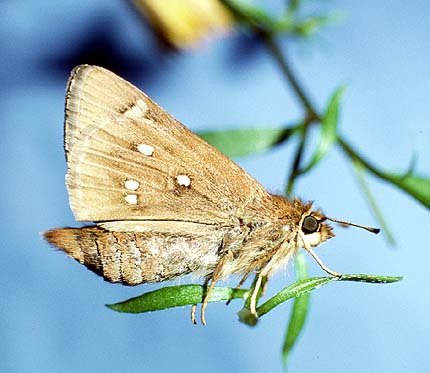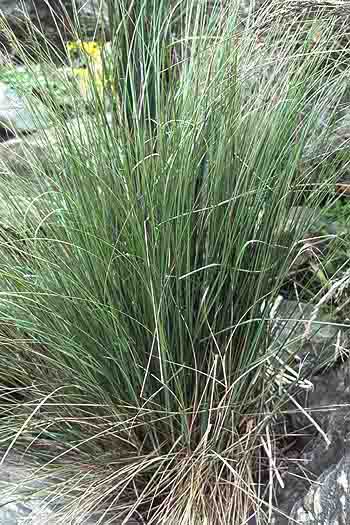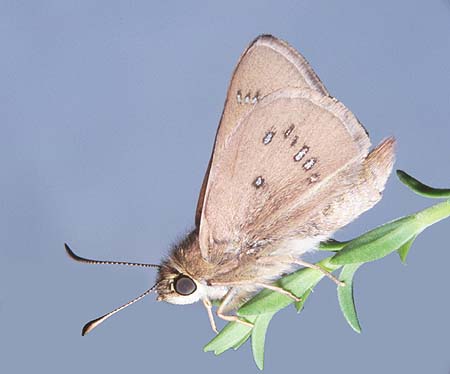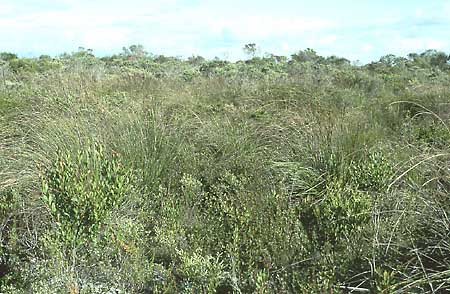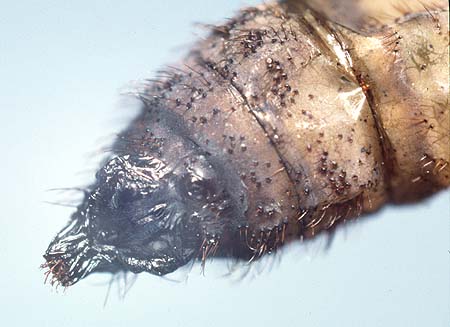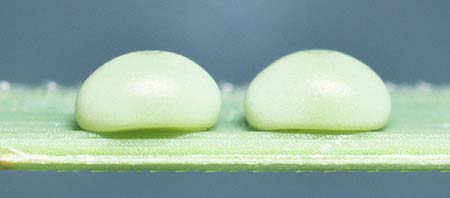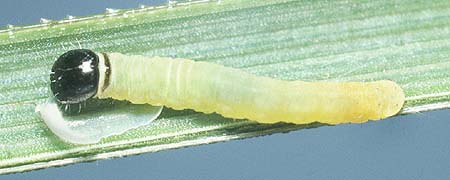-
Larval Food Host
-
Gahnia deusta (mallee saw-sedge),
G. filum (thatching grass or smooth-leaved saw-sedge),
G. radula (thatch saw-sedge),
G. sieberiana (red-fruit saw-sedge),
G. trifida (cutting grass) (Cyperaceae).
The larvae eat the leaves of the foodplant. The skipper has a preference for
G. trifida on the mainland; but on Kangaroo Island, it is more often
seen near G. sieberiana. It has been reported only once on G. deusta.
The skipper requires its habitat and foodplant to be in full sun.
-
Eggs
-
Large (2 mm along the long axis), hemi-ellipsoid with a flat base, nearly smooth
with about 54 very indistinct vertical ribs, the micropylar area on top of the
egg is depressed. Pale green with a darker green micropylar area. If fertile the
egg does not acquire purple or reddish markings as for Hesperilla donnysa
and H. idothea. Laid singly or in pairs on the leaves of the foodplant,
usually about 1/2 to 2/3 the way up from the base of the plant, within the inner
parts of the (large tussock) plant. The egg hatches after about 11-14 days.
The egg shell is eaten by the larva after its emergence.
-
Larvae
-
The first instar is long cylindrical, initially 5 mm long, the forward half of
the larva is pale green and the posterior half of the larva is yellow, but
turning green after eating the foodplant, with a large shining black head
having a few long hairs, the neck (prothoracic plate) is dark brown, and long
recurved hairs occur posteriorly. After eating the empty eggshell the larva
will eat a small portion of the foodplant to test that it is the correct
foodplant, then it moves to near the tips of the leaves to form a small tubular
shelter, by silking together two or three leaves.
Subsequent instars gradually acquire indistinct pale and dark longitudinal lines
and lose the long posterior hairs, and the head becomes dark brown and eventually
by about the fourth instar, acquires the pale brown head pattern described for
the final (fifth) instar larva. New shelters are periodically constructed in the
outer parts of the foodplant to fit the growing larvae, the internal diameter of
the shelters being almost an exact fit to the diameter of the larvae. The shelters
open at the top (towards the tips of the leaves) and during the development of the
larva it will eat the leaves back from the tips towards the shelter entrance.
In the case of this skipper, the leaves are usually silked together in a slightly
twisted manner, whereas in other Hesperilla skippers the leaves are usually
straight. Larvae feed at night for a very brief period (usually very late at night),
hiding from predators during the day inside their shelters.
The final instar is long cylindrical, about 35-40 mm long, with the last posterior
segment flattened into the anal plate, smooth, but with the posterior end having
some hairs. Semi-translucent pale green, sometimes bluish or yellowish, with a
darker dorsal line broadly edged whitish green, and sometimes there are other
indistinct longitudinal lines. The head is large, finely rugose, elongate and
slightly flattened, there is an indistinct central longitudinal furrow, the top is
rounded, and there are a few long hairs ventrally and on the sides. Pale brown
coloured with a narrow dark brownish black longitudinal median line in the front
that expands ventrally and tapers to a point at the dorsal apex, and sometimes
there is an inverted pale brown coloured V mark immediately above the mouth, and
with a small dark brown ventral blotch on either side of the head. (The side of
the head never has a dark brown vertical stripe, which differentiates these larvae
from other Hesperilla larvae in South Australia as they normally have lateral
side markings). The body, and particularly the anal plate on the last segment, is
covered in minute secondary setae that are hair-like with a blunt tip, and which are
set on simple smooth raised bases. (This feature also differentiates these larvae from
other Hesperilla larvae in South Australia as they have wine-glass shaped setae).
The final larva shelter is constructed in the outer 1/3 of the plant, and is up to 7 cm
long. Formed by joining up to six foodplant leaves together, to form a tight, silk lined
slightly twisted tubular structure, sealed at the base and opening at the top.
Larval development is usually rapid in summer and autumn with most larvae attaining early
fifth instar by winter. They continue to eat and develop slowly through winter,
and pupation normally occurs in spring. (Dependant upon variable ecological factors, six
larval instars may sometimes be required rather than the normal five instars).
The presence of larvae for this species (and for all other Hesperilla larvae)
on the foodplant are readily discernible by the distinctive looping of the foodplant
leaves resulting from the construction of the larval shelter. The leaves used in the
construction of the shelter are tightly fixed by silk to form the shelter, and as the
leaves continue to grow (from the base) the unequal growth rate of each leaf causes
the fastest growing leaves to produce a loop beneath the shelter.
-
Pupae
-
Long cylindrical, about 25-30 mm long, usually brownish black with variable amounts
of greenish or yellowish areas in the mid part, but sometimes they can be nearly all
a greenish yellow colour except for a black head and posterior end, lightly covered
in a white powdery bloom, the latter acting as a water repellent and perhaps fungicide.
Sparsely covered with short black, stiff, posteriorly directed spinose bristles on the
abdomen and dorsal part of the thorax, and which arise from short tubular bases.
The bristles become much more common towards the posterior end. The posterior end tapers
to a short, narrow, black rugose cremaster. The head is rounded, with the head cap
(operculum) being black coloured, having a characteristic rounded shape, and there are
some long hairs. The central part of the operculum is heavily sclerotised (very rugose)
and is divided into two parts, separated horizontally, with the dorsal part being the
larger segment.
Pupation occurs in the final larval shelter on the foodplant, and the larva pupates head
upwards towards the leaf tips. The pupa is secured within the silk lined shelter by very
strong hooked bristles emanating from the terminal-ventral part of the cremaster,
(same principal as velcro). The larva seals the top entrance to the shelter with a weak
silken pad before it pupates, and which has to be broken by the emerging adult. The pupal
duration is about 34 days. The empty pupal case remains inside the shelter after the adult
skipper emerges, and is brown or brownish black coloured.
The shape of the operculum and cremaster, the colour of the pupa (alive or as an empty
case), and the morphological properties of the larva or discarded larval skin are
diagnostic for the species and can be used during field surveys to differentiate
H. chrysotricha from other Hesperilla species in South Australia outside
of the flight times for the adult skippers.
Hesperilla colonies are often plagued by the large, orange-red, parasitoid
Ichneumonid wasp. The female wasp apparently lays her egg directly onto or into
the skipper larva, and considering the tight, seemingly impregnable shelter made
by the larva the wasp must inject the egg directly through the hard outer wall of
the shelter by using her rigid external ovipositor. The wasp larva eats the internal
organs of the skipper larva host, and eventually kills the skipper larva (and presumably
any other parasitic larvae as only one parasitic wasp larva remains), and pupates
inside the larval shelter after shrugging off the skipper larva skin. Judging from
the size of the shelters this must occur when the skipper larvae are in their fourth
or early fifth instars. Colonies of H. chrysotricha already under environmental
stress are likely to be put into terminal stress by this wasp.
-
Flight Period in South Australia
-
It is single brooded with the extended flight period across the state being about four
months. However, individual population flights last only about one month. The flight
starts about mid-October on Eyre Peninsula, but up to 6 weeks later elsewhere, with
those occurring in the colder elevated areas of the Fleurieu Peninsula being the last
to fly. In cold seasons the flight may be delayed by 2-3 weeks. Stragglers last into
January, and there is a single flight record for late April.

-
Distribution
-
Its original range in South Australia included southern Eyre and Yorke Peninsulas,
Kangaroo Island, the Fleurieu Peninsula, the Coorong, and the Lower Southeast region
extending into southern Victoria and Tasmania. South Australian populations were
formerly included under subspecies leucosia and ssp naua. They are now
included under the single ssp cyclospila, although individual major populations
in South Australia are reasonably distinctive. Another subspecies occurs in southwest
Western Australia. Its range has been in a steady decline in South Australia, that has
accelerated over the past 30 years. It is now extinct on Yorke Peninsula, and has been
pushed to the extreme southern areas on Eyre and Fleurieu Peninsulas. It is probably
extinct in the Coorong and is present only in a few coastal conservation parks in the
Lower Southeast. On Kangaroo Island it is now mostly found on the western half of the
island.
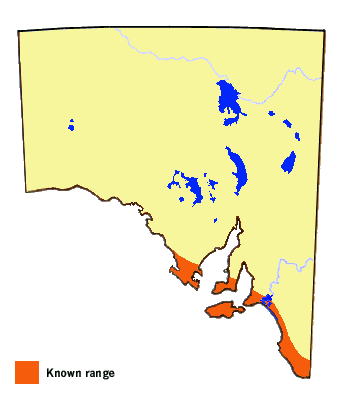
-
Habitat
-
In South Australia this skipper is confined to saw-sedge wetlands in the cool-temperate
coastal and near coastal creek-line and upland spring environments.
-
Conservation Status in South Australia
-
Vulnerable. The mainland habitat of this skipper is now severely fragmented and
degraded, due to urbanisation and agricultural use. The skipper shares the same
coastal habitat as the endangered Orange Bellied Parrot and the Emu Wren, and
their fates are now intricately linked. Population numbers of the skipper on the
mainland are now extremely low where it rarely recolonises a previous habitat.
On Kangaroo Island where there has been a better retention of wetland habitat
the butterfly is still stable, but localized in distribution.
-
Threats
-
On the mainland, this skipper has suffered considerably from the agricultural and
urban disturbances of its saw-sedge wetland habitat. In historical times these
wetlands were cleared, drained and burnt off, but the tenacious regrowth habit of
the saw-sedges often won out. However, more aggressive farmers endured causing the
wetlands to become severely fragmented. Due to the tall tussock growth habit of the
saw-sedges it is usually cattle that are allowed to graze these wetlands, which they
do very effectively when hungry, by eating and trampling the sedges back to near
ground level. Remnant saw-sedge wetlands continue to be drained, putting terminal
summer stress on the saw-sedges causing them to in-roll their leaves, which makes
them unpalatable to the larvae of the skipper. Most saw-sedge bearing creeklines are
now choked and smothered with weeds and introduced trees, particularly African
feather-grass, ash, blackberry, broom, couch, ivy and kikuyu. Irresponsible disposal
of urban and agricultural waste products and toxins inevitably end up in wetlands,
the effects of which are ultimately going to have a detrimental effect on the wetland
community, including this skipper, and it is apparent this skipper does not appear to
be able to handle too much degradation of its habitat.
Colonies under environmental stress are quite possibly finished off by the parasitoid
effects of the large orange-red, Ichneumonid wasps.
It is not known if this skipper is mutually compatible with Hesperilla donnysa
in situations where they fly together, (due to male territorial battles). The latter
is a very tough and adaptable skipper, tolerant of very degraded wetlands.
-
Conservation Strategy
-
The retention of pristine saw-sedge wetland habitat is essential for the survival of
this skipper in South Australia, and specific habitat may have to be conserved for
its long-term survival. There needs to be a major revegetation of suitable creeklines
with the saw-sedge foodplants, and the latter should be included in all suitable
revegetation projects. Remaining saw-sedge wetlands used for pastoral purposes need to
be managed in an ecologically sustainable manner, and ideally, suitable wetlands need
to be fenced off from the destructive feeding habits of grazing domestic stock.
(Unfortunately, most wetlands on private land, usually dairy-land, are used as a backup
food source for the cattle due to the adjacent pasture land having been severely overgrazed. )
The control of mosquitoes in remaining broad-acre saw-sedge wetlands through the use of
broad spectrum insecticides by aerial means needs to be judicially controlled, but
preferably should cease, as it can be a major cause of fauna destruction. The draining
of remaining pristine wetlands needs to cease, as this practice causes summer stress to
the Gahnia that is ultimately fatal to Hesperilla larvae. The dumping of
urban vegetation waste into creeklines and wetlands needs to cease. There needs to be a
major public education process about the continuing degradation effects on wetlands.
